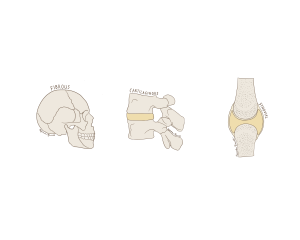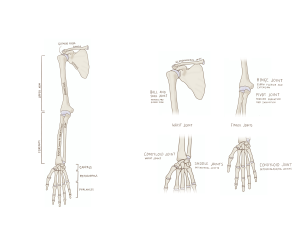34 Joint Types
Three Main Types of Joints:
On construction sites, you can often find arm-like machines known as excavators that are used to dig gravel. The arm on these excavators contains an elbow-like bend for scooping soil into its bucket. Like the bend in the excavator, humans have joints to facilitate movement and flexibility. Joints are where two bones meet. Here are the three main types of joints:

Figure 74 Three joint types
Table 37 Description of joint types
| Type of joint | Description | Movement | Example |
| Fibrous | Made of dense connective tissue | Little to no movement | Sutures in the skull |
| Cartilaginous | Made of cartilage | Limited movement | Joints between the vertebrae in the spine |
| Synovial | Filled with synovial fluid | Wide range of movements | Hinge Joints (e.g., elbow)Ball-and-Socket Joints (e.g., shoulder and hip) |
Synovial Joints:
Although joints are generally classified into three main types, synovial joints are the most important for performing complex movements, like throwing a dart or kicking a ball. Synovial joints allow for the greatest range of motion due to the articular surfaces of the bones which are covered with smooth hyaline cartilage, which reduces friction and helps absorb shock during movement.
Synovial joints are the most mobile joints in the body, but not all of them move in the same way. The shape of a joint determines how it moves and in how many directions. For example, think about two common tools you might use in the garage: a wrench and a screwdriver. Both can tighten or loosen bolts, but each works differently because of its shape. Similarly, joints in the body are designed in specific ways to allow for different types of movement.
Some joints move in just one direction (like bending and straightening), while others allow movement in two or multiple directions. Here’s a breakdown of the types of synovial joints and how they differ according to their planes of movement:
- Uniaxial joints: These joints move in only one plane. This allows for simple movements like flexion and extension. Think of the elbow or knee, both bend and straighten, but neither rotate or move sideways.
- Biaxial joints: These joints allow movement in two different planes. This provides more flexibility than uniaxial joints. A great example is the wrist, which moves not only up and down (flexion and extension) but also side to side (abduction and adduction).
- Multiaxial joints: These joints move in many directions. They allow for the most versatile movement, including rotation. The shoulder joint is a great example, enabling you to rotate your arm, lift it above your head, move it sideways, and more.
Here’s how synovial joints are grouped based on their movements:

Figure 75 Examples of the types of synovial joints
Table 38 Types of synovial joints
| Subtype | Planes of Movement | Movements | Examples |
| Hinge | Allows movement in one plane | Flexion, extension | Elbow, knee |
| Condyloid | Allows movement in two planes | Flexion, extension, abduction, adduction | Wrist |
| Planar | Allows sliding movements between flat surfaces | Gliding (sliding) movements | Intercarpal bones of the hand, intertarsal bones of the foot |
| Pivot | Permits rotational movement around a single axis | Rotation (e.g., turning the head from side to side) | At the junction between the head and neck |
| Saddle | Permits movement in two planes with greater range than condyloid joints | Flexion, extension, abduction, adduction, opposition | Base of the thumb |
| Ball-and-socket | Allows movement in multiple planes, including rotation | Flexion, extension, abduction, adduction, rotation, circumduction | Shoulder, hip |
Movement:
Before diving into muscle groups and their actions at a given joint, let’s pause and ask ourselves: What factors dictate the types of movements produced at the joints?
Several factors affect how muscles move at a joint, and understanding them gives insight into how our bodies function. While the type of joint plays a major role, there are also two other key factors: muscle placement and muscle fiber orientation.
Muscle Placement:
The position of a muscle relative to a joint is key to determining the movement it produces. Imagine placing a string along the front of your arm, with one end attached to the humerus (bone of the arm) and the other on the radius or ulna (bones of the forearm). If you were to shorten the string, the forearm would move closer to the shoulder, demonstrating flexion at the elbow joint. In the same way, muscles positioned on the anterior side of a joint will produce flexion when they contract, while muscles positioned on the posterior side of a joint will exert extension when they contract.
Muscle Fiber Orientation:
Muscle fiber orientation is another important factor in determining how our body moves. Muscles that have fibers running in different directions can produce different kinds of movements. For example, while muscles on your back primarily help with extension, some also assist with rotation. This happens because of how their fibers are oriented.
Take the rectus abdominis (the “six-pack” muscles) as an example. It runs vertically, so it helps with flexing the spine forward. On the other hand, the obliques, which run at an angle, assist with rotation and bending sideways (lateral flexion) at the trunk. The angle at which muscle fibers are aligned has a direct impact on the direction and function of muscle movement.
By learning the mechanics of how muscles work and how their placement and fiber orientation affect movement, you can stop relying on memorization and instead actually understand why muscles work the way they do.
Muscle (Group) Actions:
Now that we’ve covered the factors that influence movement, such as joint type, muscle placement, and fiber orientation, it’s time to examine how specific muscle groups in the upper limb, lower limb, and trunk contribute to the wide variety of motions we use in our everyday life. These muscle groups are organized by their location and their actions at different joints are directly related to their function.

